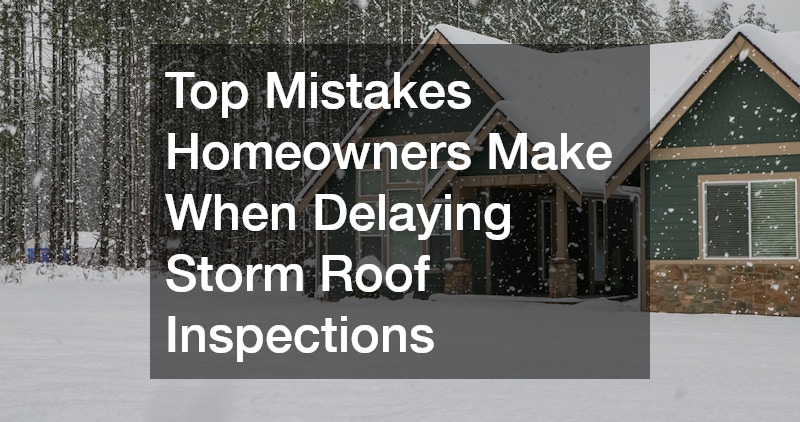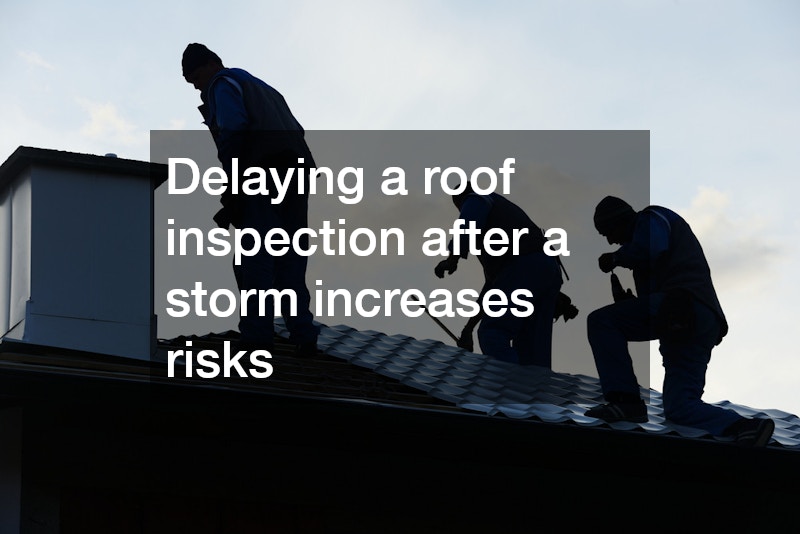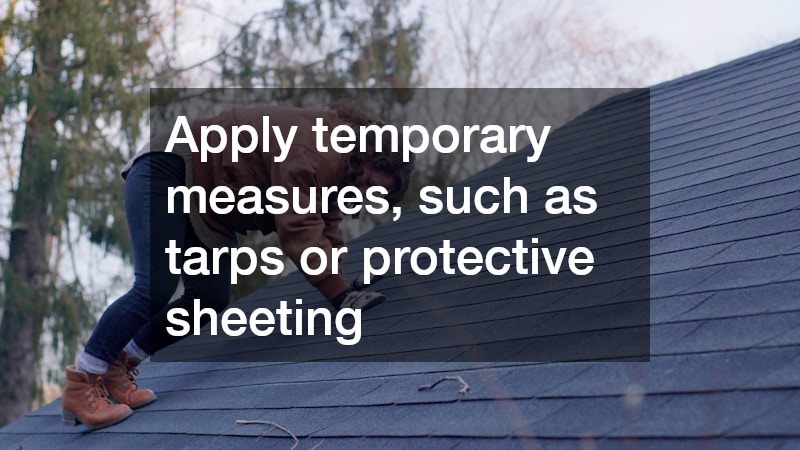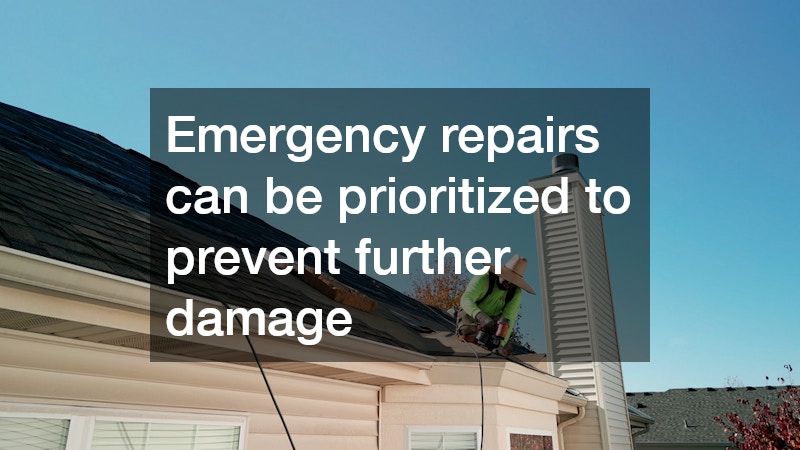Key Takeaways
-
Delaying inspections can worsen damage and increase repair costs.
-
Same-day inspections by certified roofers for storm inspections identify hidden and visible issues.
-
Accurate documentation supports insurance claims and protects financial interests.
-
Emergency storm roof contractors can apply temporary measures to prevent further damage.
-
Maintaining a storm response plan and professional contacts minimizes risk and ensures timely action.

Severe weather events such as hailstorms, high winds, or heavy rain can leave a roof vulnerable to both visible and hidden damage. Many homeowners assume that if no immediate leaks appear, their roof is fine. However, even minor damage can escalate quickly if left uninspected. Missing shingles, loosened flashing, or compromised underlayment can lead to water infiltration, mold growth, structural weakening, and extensive interior damage. Delaying an inspection not only increases the potential for repair costs but can also jeopardize insurance claims. Certified roofers for storm inspections play a critical role in identifying and documenting damage promptly, providing homeowners with a clear assessment that insurance providers recognize as credible.
Acting quickly ensures that any damage is recorded accurately, emergency repairs are prioritized, and hidden risks are mitigated before they evolve into larger problems. Homeowners who delay contacting certified roofers for storm inspections often face complications that could have been avoided with prompt professional assessment.
Why Same-Day Storm Roof Inspections Are Essential
Roof damage can escalate within hours after a storm, especially when water penetration occurs through minor openings. Same-day inspections conducted by certified roofers for storm inspections allow for a thorough assessment before conditions worsen. These professionals use specialized tools and methods to detect structural weaknesses, moisture accumulation, and underlying damage that is invisible to the untrained eye. Waiting even a few days can result in water damage to insulation, ceilings, and walls, and may increase the risk of mold or rot.
Insurance providers often require documentation of storm damage within a narrow timeframe. Scheduling a same-day inspection helps meet policy requirements, improves the likelihood of claim approval, and ensures accurate repair estimates. Emergency storm roof contractors can quickly identify urgent repairs, protecting both the homeowner’s property and long-term financial interests.
-
Immediate detection prevents minor issues from escalating into costly repairs.
-
Professional inspections provide credible reports for insurance purposes.
-
Hidden problems like torn underlayment, loose flashing, or structural weakness are identified early.
-
Emergency repairs can be prioritized to prevent further damage.
-
Early assessment can help homeowners avoid additional damage from secondary storms, snow, or rain.
-
Same-day inspections often allow insurance adjusters to verify damage promptly, reducing claim disputes.
Common Mistakes Homeowners Make When Delaying Inspections
Even when storms cause visible damage, homeowners frequently postpone professional inspections. This delay can result from misconceptions about the severity of the damage or underestimating the risks of hidden issues.
-
Assuming minor damage is harmless: Homeowners often focus only on visible damage like a few missing shingles while ignoring signs of structural compromise or water intrusion beneath the surface. Small imperfections can allow moisture to penetrate roofing materials, gradually weakening the roof deck and supporting structures.
-
DIY assessments: Attempting to inspect the roof without proper equipment or knowledge can result in overlooked damage or accidents. Untrained homeowners might fail to identify loose flashing, lifted shingles, or hidden punctures that could later cause leaks.
-
Scheduling delays: Busy schedules or reluctance to call a professional may result in days or weeks passing before the roof is evaluated. During this time, damage can worsen, and interior problems may start to appear.
-
Ignoring insurance requirements: Many policies require damage to be reported promptly. Failing to schedule certified roofers for storm inspections can lead to claim denials or reduced payouts.
Red flags that indicate delayed action may be risky:
-
Shingles appear intact, but flashing, vents, or gutters are loosened.
-
Debris remains on the roof, increasing the risk of water pooling or further damage.
-
Small leaks start appearing in the attic or ceilings over time.
-
Homeowners attempt temporary fixes without professional evaluation, which may void insurance coverage.
-
Roof decking shows early signs of sagging or water damage visible from the attic space.
Risks of Waiting to Inspect the Roof
Delaying a roof inspection after a storm significantly increases risks. Water infiltration and wind damage can progress unnoticed, affecting both the roof structure and the interior of the home.
-
Escalating roof damage: Even minor shingle displacement or lifted flashing can compromise the roof’s waterproofing, leading to structural rot and weakened decking.
-
Interior and secondary damage: Leaks may extend to insulation, ceilings, and walls, sometimes resulting in mold growth that poses health risks. Delayed inspections allow moisture to spread, increasing the area and cost of repairs.
-
Insurance complications: Most insurance providers require prompt documentation. Delayed inspections can reduce claim payouts or result in full denial.
-
Safety concerns: Compromised roofs are hazardous, particularly if homeowners attempt DIY repairs. Roof collapses, falls, or accidents from unstable areas become more likely over time.
Key risks summarized:
-
Water leaks spreading throughout the home.
-
Hidden structural weaknesses worsening over time.
-
Denied or reduced insurance claims.
-
Mold growth and associated health hazards.
-
Increased repair costs and potential for emergency replacement.
-
Safety risks for anyone performing temporary repairs.
-
Additional damage from debris, wind, or secondary storms affecting the roof.
-
Insurance disputes arising from delayed professional documentation.
Certified roofers for storm inspections are trained to identify these risks promptly, allowing homeowners to take preventive measures before damage escalates.

Understanding Insurance Requirements
Insurance coverage often dictates how quickly a storm-damaged roof must be assessed. Many homeowners are unaware that delaying inspections can directly impact claim approval.
-
Timelines: Most policies require damage reporting within days or weeks. Missing this window may result in partial or total denial of a claim.
-
Documentation: Insurers require photos, videos, and professional reports. Certified roofers for storm inspections provide detailed evaluations that meet these standards.
-
Coverage: Policies may include wind, hail, or water damage. Prompt inspection ensures that eligible damage is documented accurately.
-
Temporary repairs: Emergency storm roof contractors can provide temporary fixes that protect the home while claims are processed, without affecting insurance coverage.
Insurance compliance tips:
-
Know your policy’s deadlines for reporting damage.
-
Contact certified roofers for storm inspections immediately after the storm.
-
Take photos and videos of visible and hidden damage.
-
Document any temporary protective measures applied.
-
Confirm which types of damage are covered to prioritize repairs.
-
Keep all documentation organized for future reference, including contractor reports and inspection notes.
How to Conduct a Safe Initial Assessment
While professional inspections are essential, homeowners can take safe, initial steps to document visible damage.
-
Conduct a visual assessment from the ground to spot missing shingles, sagging areas, or debris. Use binoculars if necessary to safely inspect areas at height.
-
Avoid walking on the roof, especially when wet or damaged. Falls can result in serious injury.
-
Take comprehensive photos and videos from multiple angles to capture both obvious and subtle damage.
-
Apply temporary measures, such as tarps or protective sheeting, to prevent water ingress if feasible.
-
Schedule a certified roofer for storm inspections promptly for a thorough evaluation, especially if interior leaks are suspected.
Checklist for safe assessment:
-
Look for cracked, lifted, or missing shingles.
-
Examine vents, chimneys, flashing, and gutters for damage.
-
Note weak, sagging, or punctured areas on the roof deck.
-
Safely remove debris without causing additional damage.
-
Document everything clearly for insurance claims.
-
Prioritize emergency repairs if immediate threats are identified.
-
Keep notes on any interior water stains or attic damage that could indicate hidden leaks.

Best Practices for Timely Storm Roof Inspections
Homeowners can take several steps to ensure timely and effective inspections:
-
Maintain an emergency contact list of certified roofers for storm inspections who are available after major weather events.
-
Understand your insurance policy’s deadlines and coverage to avoid missed claim opportunities.
-
Document all visible and potential damage immediately with photos, videos, and detailed notes.
-
Schedule professional inspections promptly, ideally same-day, especially after severe storms.
-
Implement routine roof maintenance to reduce vulnerabilities, such as clearing debris, trimming overhanging branches, and ensuring gutters are functional.
-
Apply temporary protective measures, such as tarps, to prevent further damage until professional repairs can be made.
-
Keep all inspection reports organized for insurance purposes and future reference.
By adopting these practices, homeowners reduce the risk of denied claims, expensive repairs, and structural damage. Certified roofers for storm inspections can guide homeowners through every step, ensuring both safety and insurance compliance.
Delaying a roof inspection after a storm can result in worsening damage, high repair bills, and denied insurance claims. Same-day storm inspections conducted by certified roofers for storm inspections provide timely, accurate evaluations, professional documentation, and guidance for emergency repairs. Prompt action ensures hidden damage is identified, insurance claims are supported, and homeowners are protected from unexpected expenses.
Proactive inspection, proper documentation, and engagement with licensed contractors are critical to maintaining roof integrity, protecting your home, and maximizing insurance coverage. Waiting may seem convenient, but in storm situations, acting quickly is essential to avoid significant costs and structural problems.
